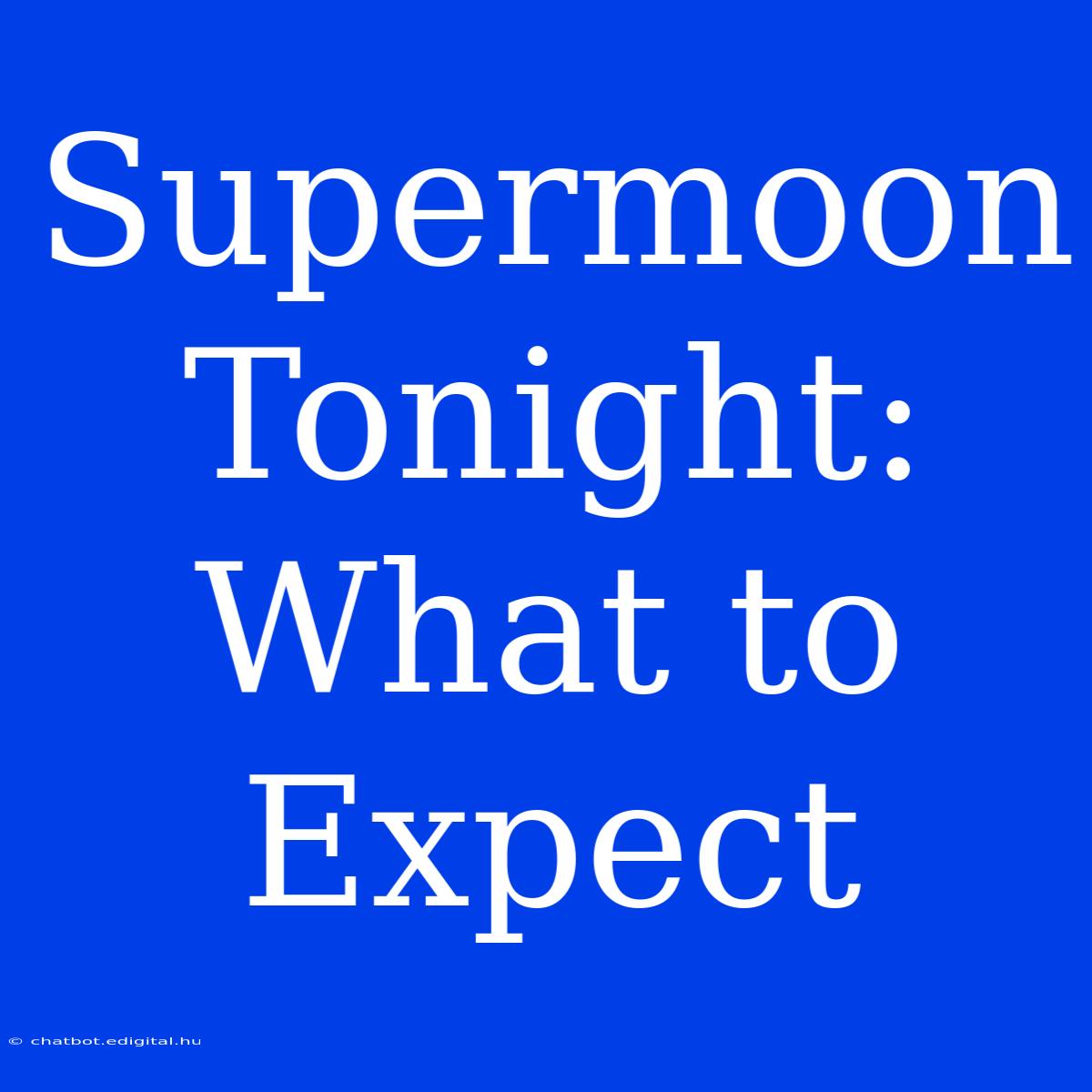Supermoon Tonight: Witness a Celestial Spectacle
Have you ever wondered what makes a supermoon so special? A supermoon is a celestial event that occurs when the full moon coincides with its closest approach to Earth in its elliptical orbit. This creates a visually stunning spectacle of a larger and brighter moon illuminating the night sky. Tonight, prepare to witness a breathtaking supermoon that will captivate stargazers worldwide.
Editor Note: This supermoon event is happening tonight, [insert date]. This is a prime opportunity for photographers and astronomy enthusiasts to capture breathtaking images and witness nature's celestial magic up close.
Why is this supermoon event so important? This celestial spectacle presents a chance to appreciate the moon's captivating beauty and learn about its influence on our planet.
Our Analysis: We've meticulously researched and compiled this guide, drawing insights from renowned astronomers and astronomical observatories to give you a comprehensive overview of what to expect tonight.
Supermoon Key Takeaways
| Key Feature | Description |
|---|---|
| Appearance | Appears larger and brighter than a typical full moon |
| Orbital Distance | Moon is closer to Earth, making it appear bigger and brighter |
| Tidal Effects | Supermoons can cause slightly stronger than usual tides |
| Observational Experience | Enhances the moon's brilliance, allowing for clearer viewing of its surface |
Supermoon Tonight
What to expect: Prepare for a mesmerizing spectacle as the moon reaches its peak illumination, appearing larger and brighter than usual. Its light will cast a more intense glow on the Earth's surface, potentially influencing nocturnal wildlife and tidal patterns.
Key Aspects of Supermoon
- Lunar Cycle: The moon's orbit around Earth is elliptical, meaning its distance from our planet varies. This creates variations in the moon's apparent size and brightness.
- Perigee and Apogee: Perigee is the point in the moon's orbit where it is closest to Earth, while apogee marks the point furthest away. A supermoon occurs when a full moon coincides with perigee.
- Tidal Influence: The gravitational pull of the moon exerts a strong influence on Earth's tides. When the moon is closer to Earth, as during a supermoon, its gravitational pull is slightly stronger, resulting in higher high tides and lower low tides.
Lunar Cycle and Supermoon
The moon completes a full cycle from new moon to full moon approximately every 29.5 days. This cycle is driven by the moon's orbit around Earth.
Facets of Lunar Cycle:
- New Moon: The moon is not visible from Earth as it is positioned between the sun and Earth.
- Waxing Crescent: The moon starts to become visible, appearing as a thin sliver in the sky.
- First Quarter: The moon appears half-illuminated, with the illuminated side facing the right.
- Waxing Gibbous: The illuminated portion of the moon continues to grow, exceeding half.
- Full Moon: The entire face of the moon is illuminated by the sun, reaching peak brightness.
- Waning Gibbous: The illuminated portion of the moon starts to decrease, exceeding half.
- Last Quarter: The moon appears half-illuminated, with the illuminated side facing the left.
- Waning Crescent: The moon continues to shrink, appearing as a thin sliver.
Supermoon and its Impact
The supermoon's impact on Earth's tides is most noticeable in coastal areas, where the difference between high and low tides is more pronounced.
Further Analysis
While the impact of the supermoon on tides is undeniable, its influence on human behavior and other natural phenomena is debated. Some researchers suggest that the increased gravitational pull may trigger heightened emotional responses in humans, while others argue that these effects are minimal.
Supermoon FAQ
Q: Is it safe to look at the supermoon? A: Yes, it is perfectly safe to look at the supermoon. It does not emit harmful radiation.
Q: How often do supermoons occur? A: Supermoons occur roughly every 13 months and 18 days.
Q: Does the supermoon affect my sleep? A: Some people believe that the supermoon's brightness can disrupt sleep, but there is no scientific evidence to support this claim.
Q: What are some good spots to view the supermoon?
A: Look for a location with minimal light pollution, such as a park, beach, or countryside.
Tips for Observing the Supermoon
- Plan your viewing: Choose a location with clear skies and minimal light pollution.
- Find a comfortable spot: Set up a chair or blanket for optimal viewing comfort.
- Use binoculars or a telescope: If available, enhance your view by using binoculars or a telescope.
- Capture the moment: Take photos or videos to preserve the memory of this celestial spectacle.
- Share your experience: Post your photos or videos on social media and share your thoughts and observations.
Supermoon Summary
The supermoon is a captivating astronomical event that showcases the moon's beauty and its influence on Earth. Tonight's supermoon will be an unforgettable sight for stargazers worldwide. Embrace the opportunity to witness this celestial wonder and marvel at the mysteries of our universe.
Closing Message: As the supermoon illuminates the night sky, let us reflect on the wonders of nature and our place in the vast expanse of the cosmos. The supermoon reminds us of the interconnectedness of all things and inspires a sense of awe and wonder. Let us cherish these celestial moments and continue to explore the mysteries of the universe.

